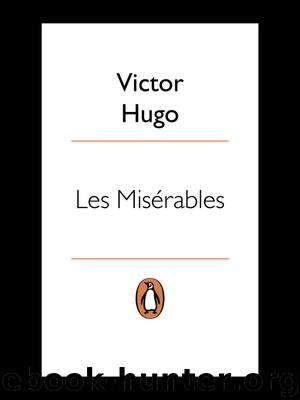Les Miserables (Penguin Clothbound Classics) by Victor Hugo

Author:Victor Hugo [Hugo, Victor]
Language: eng
Format: azw3
ISBN: 9780141921518
Publisher: Penguin Books Ltd
Published: 2003-04-24T04:00:00+00:00
IV
The gang
These four formed a single, Protean body, wriggling through the meshes of the law, evading the scrutiny of Vidocq ‘in diverse guises, tree, flame and fountain’, exchanging names and stratagems, vanishing into their own shadow, each the confidant and protector of the others, changing their outer aspect as one takes off a false nose at a masked ball, sometimes merging together to the point of being one person and at other times so multiplying themselves that they might be taken for a mob. They were not four men but a sort of four-headed monster preying wholesale on Paris, a monstrous embodiment of the evil lurking in the catacombs of society.
Thanks to their many and various enterprises, and their network of criminal contacts, Babet, Gueulemer, Claquesous, and Montparnasse had become in some sort the headquarters of villainy throughout the Département de la Seine. They were the setters of traps, the stabbers in the back. Persons desiring this kind of service, men with dark ambitions, applied to them. They put forward a project, and the foursome saw to it that it was carried out. They worked to specification, and were always able to find suitable assistants where additional manpower was needed, and provided the job covered the expense. Where the drama required a supporting cast they hired them, having at their disposal a company of small-time actors sufficient for any play.
They were accustomed to meet at nightfall, the time of their awakening, in the wasteland near the Salpêtrière. Here they took counsel together; with twelve hours of darkness ahead of them, they decided upon its use.
This four-man syndicate was known to the underworld by the name of ‘Patron-Minette’. In the old popular slang, which is fast disappearing, ‘Patron-Minette’ meant ‘morning’ and ‘Entre chien et loup’ meant ‘evening’; no doubt the name was a reference to the conclusion of their labours, daybreak being the hour when ghosts vanish and thieves disperse. They were always referred to by this name. When the President of the Assize Court visited Lacenaire in gaol he mentioned a crime which Lacenaire denied having committed. ‘Then who was it?’ he asked. Lacenaire’s reply was mystifying to the magistrate but intelligible to the police: ‘It may have been Patron-Minette’.
One may sometimes deduce the nature of a play from the names of the characters; in the same way, one may get some idea of the nature of a gang. Here then are the names of the principal accomplices of Patron-Minette, names still to be found in the police archives:
Panchaud, alias Printanier, alias Bigrenaille.
Brujon (there was a dynasty of Brujons, of whom mention will be made later).
Boulatruelle, the road-mender whom we have already met.
Laveuve.
Finistère.
Homère Hogu, a black man.
Mardisoir.
Dépèche.
Fauntleroy, alias Bouguetière.
Glorieux, an ex-convict.
Barrecarrosse, alias Monsieur Dupont.
Lesplanade-du-Sud.
Poussagrive.
Carmagnolet.
Kruideniers, alias Bizarro.
Mangedentelle.
Les-pieds-en-1’air.
Demi-liard, or Deux-milliards.
Et cetera.
Download
This site does not store any files on its server. We only index and link to content provided by other sites. Please contact the content providers to delete copyright contents if any and email us, we'll remove relevant links or contents immediately.
Evelina by Fanny Burney(26797)
Evelina, Or, the History of a Young Lady's Entrance into the World by Fanny Burney(26232)
Twilight of the Idols With the Antichrist and Ecce Homo by Friedrich Nietzsche(18504)
Pale Blue Dot by Carl Sagan(4912)
The Perks of Being a Wallflower by Stephen Chbosky(4575)
Dune 01 Dune by Frank Herbert(4313)
Double Down (Diary of a Wimpy Kid Book 11) by Jeff Kinney(4207)
Man and His Symbols by Carl Gustav Jung(4069)
Walking by Henry David Thoreau(3894)
Separate Beds by LaVyrle Spencer(3771)
Ficciones by Jorge Luis Borges(3573)
FOUNDATION AND EMPIRE by Isaac Asimov(3551)
The 101 Dalmatians by Dodie Smith(3454)
Mystery at School by Laura Lee Hope(3371)
Anna and the French Kiss by Stephanie Perkins(3319)
120 Days of Sodom by Marquis de Sade(3182)
Some Prefer Nettles by Tanizaki Junichiro(2842)
The Little Prince by Antoine de Saint-Exupéry(2828)
My Ántonia by Willa Cather(2812)
